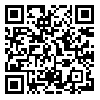BibTeX | RIS | EndNote | Medlars | ProCite | Reference Manager | RefWorks
Send citation to:
URL: http://journal.zums.ac.ir/article-1-129-fa.html
Background & Objective: Down syndrome is one of the most common chromosome aneuploidies causing mental retardation which occurs in approximately 1/230 pregnancies. It is usually caused by the presence of an extra chromosome 21. The aim of this study was to evaluate the simple PCR based DNA diagnostic method and also to determine the parental origin of the extra chromosome 21 in trisomal Down syndrome.
Materials & methods: To determine the polymorphism rates of chromosome 21 microsatellite markers, 50 people from Eastern Azarbayjan were randomly selected and studied for the microsatellites. The results were statistically analyzed. Thirty affected Down syndrome patients, diagnosed by specialists were referred to the lab for further molecular analysis. After genetic counseling and getting consent, blood samples were obtained. Seven pairs of chromosome 21 microsatellite markers were amplified using PCR in all the samples.
Results: Five highly polymorphic microsatellite markers were selected from a total seven markers, studied in 50 normal people. Out of 30 Down syndrome’s patients, trisomal 21 was diagnosed in 21 families (70%). In which non-disjunction errors were determined to be of maternal origin in 86% and of paternal origin in 9% of the cases. The mean maternal and parental age was 33/3 and 36/2, respectively.
Conclusion: The three microsatellite markers, D21S1910, D21S1411 & D21S11 could diagnose a high percentage of trisomal 21 in Down syndrome’ patients. The parental origin of an extra copy of chromosome 21 could be exactly determined.
دریافت: 1386/8/22 | پذیرش: 1393/4/9 | انتشار: 1393/4/9
| بازنشر اطلاعات | |
 |
این مقاله تحت شرایط Creative Commons Attribution-NonCommercial 4.0 International License قابل بازنشر است. |




